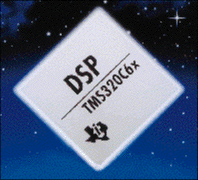1997 Editors' Roundup:
DSP, firmware, and mass storage
The year saw significant advances in digital signal processing, with
the promise of a common integer/floating-point instruction set. Also, IC
packaging, remote access to small electronic devices, and mass storage
took significant leaps.
Last spring, Texas Instruments (Dallas, TX) announced the TMS320-C6201,
a digital signal processor like no other (see Electronic Products ,
April 1997, p. 53). Its multiple execution units are dispatched by very-long-instruction-word
instructions, and its combined power can execute 10 to 15 V.34 modems simultaneously.
It is shipping now for $96 each in lots of 25,000.
In September, the company preannounced a floating-point family, the
320C670X, that duplicates the instruction-set architecture of the '6201
with extensions.

Texas Instruments TMS320C6201
The floating-point chip will become an invaluable tool for algorithm
testing. Code that is debugged on the floating-point chip can be tested
for exponent changes, then modified to keep within bounds on the integer
part.
Startup Alpine Semiconductor (Campbell, CA) devised a way to make multichip
modules using reject silicon and obsolete semiconductor fabrication equipment
(see Electronic Products , June 1997, p. 17). By solder-bumping individual
chip substrates, the process makes the bare silicon testable and bondable
without bumping the die or the larger substrate.
Web browsers more and more became the terminals of choice for remote
access to embedded systems during 1997. Software developer emWare (Midvale,
UT) extended the possibilities into simple 8-bit microcontrollers by developing
an http server that takes up only 750 bytes of 8051 code (see Electronic
Products , July 1997, p. 73).
The microcontroller code contains byte tokens for the visual HTML elements.
These are translated in a lookup either in the machine hosting the browser,
or in some intermediate server, where code space is not an issue. The system
has been applied to a device as simple as a door lock, using a PIC microprocessor.
Data storage density has been improving rapidly for years, but 1997
saw an innovation that will make a tenfold jump in capacity, sustainable
through future process improvements (see Electronic Products , April
1997, p. 21). Terastor (San Jose, CA) developed a nearfield magneto-optical
recording head that tightly focuses a laser beam while flying on an air
film, just like an ordinary hard-disk head, although it needn't be as close.
–Rodney Myrvaagnes
Advertisement





